高考英语句子成分和句子结构课件(41张ppt)
文档属性
| 名称 | 高考英语句子成分和句子结构课件(41张ppt) |  | |
| 格式 | pptx | ||
| 文件大小 | 1.1MB | ||
| 资源类型 | 教案 | ||
| 版本资源 | 通用版 | ||
| 科目 | 英语 | ||
| 更新时间 | 2022-11-20 18:24:37 | ||
图片预览

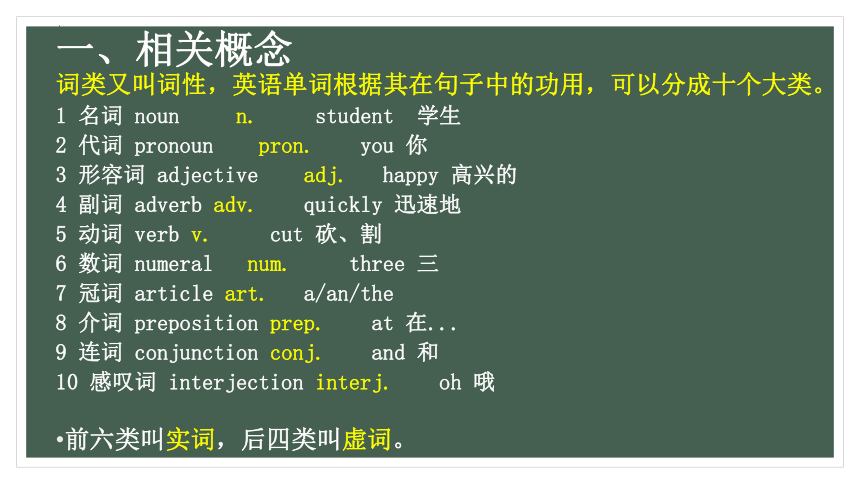
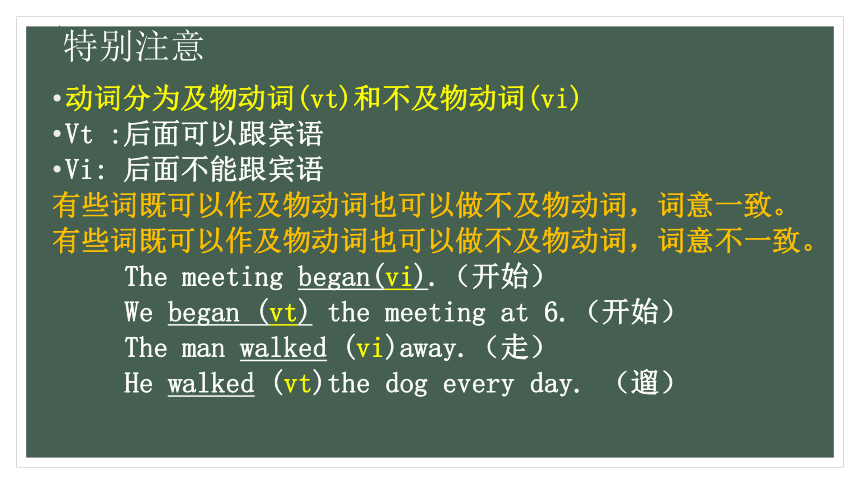
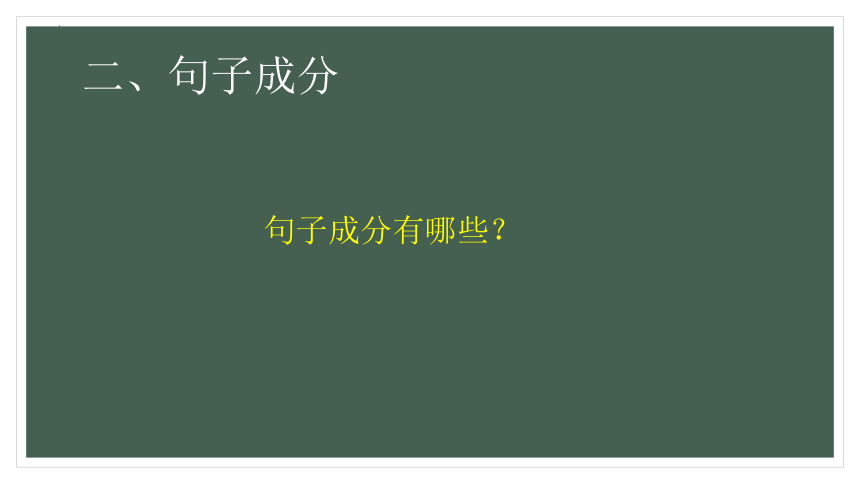
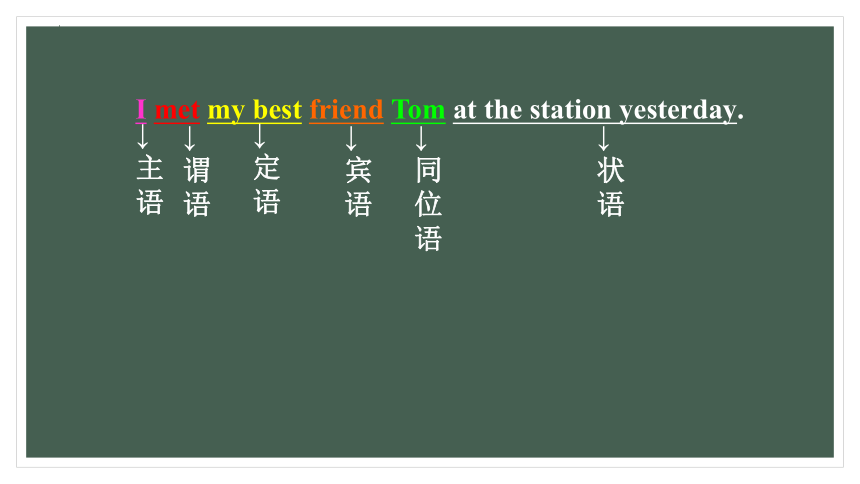
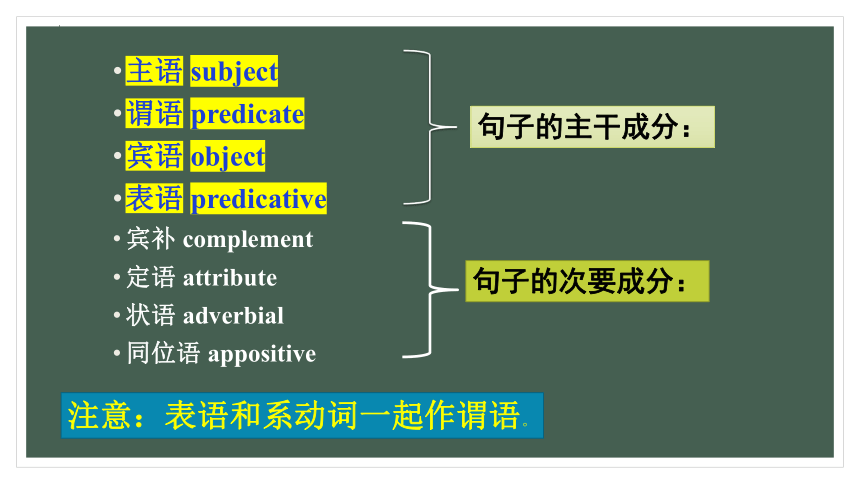
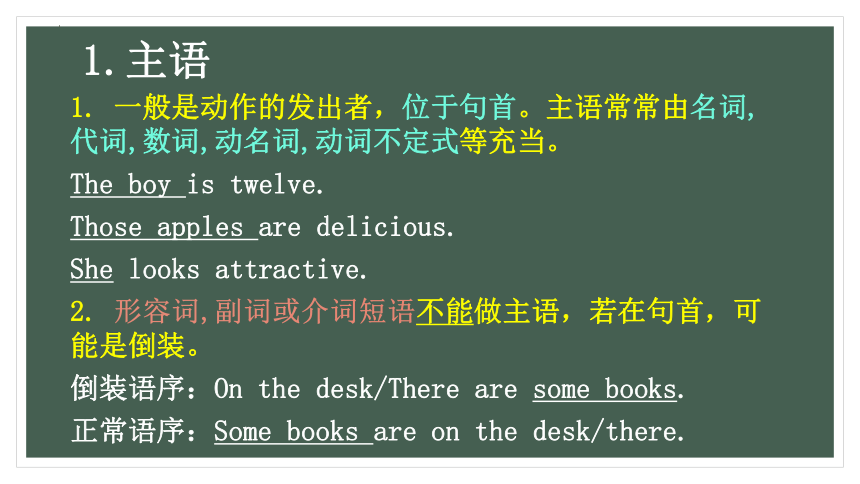
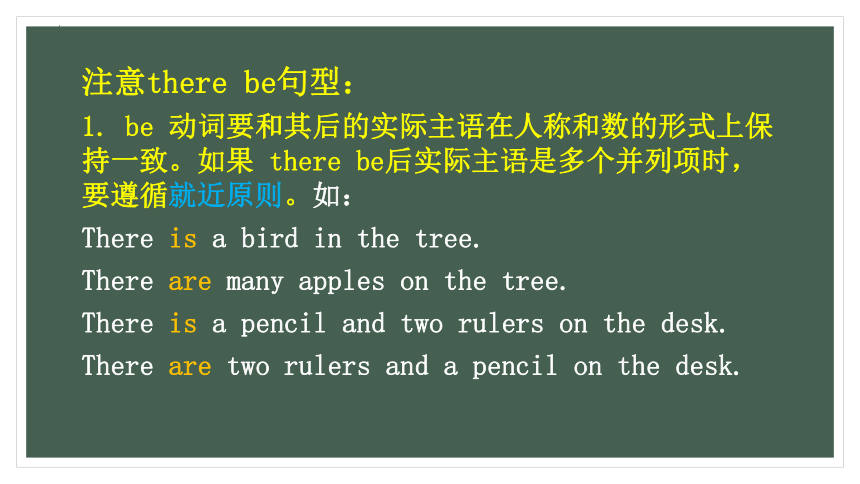

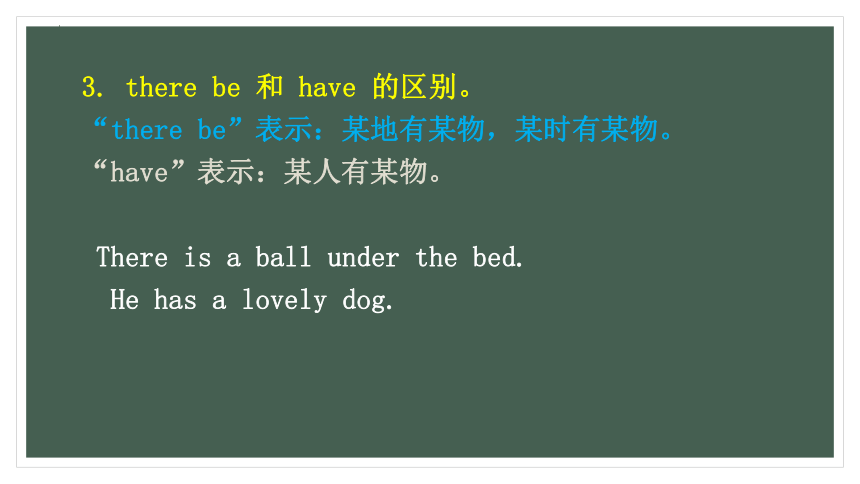

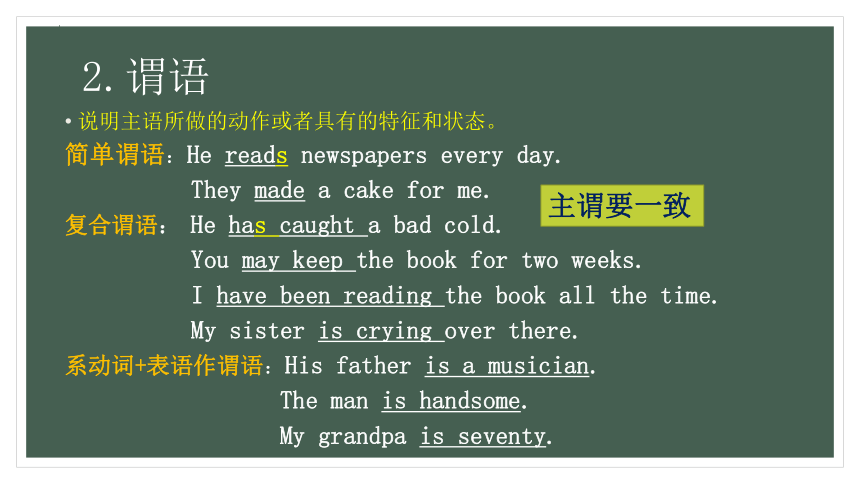
文档简介
(共41张PPT)
句子成分和句子结构
good-better-best
一、相关概念
词类又叫词性,英语单词根据其在句子中的功用,可以分成十个大类。
1 名词 noun n. student 学生
2 代词 pronoun pron. you 你
3 形容词 adjective adj. happy 高兴的
4 副词 adverb adv. quickly 迅速地
5 动词 verb v. cut 砍、割
6 数词 numeral num. three 三
7 冠词 article art. a/an/the
8 介词 preposition prep. at 在...
9 连词 conjunction conj. and 和
10 感叹词 interjection interj. oh 哦
前六类叫实词,后四类叫虚词。
特别注意
动词分为及物动词(vt)和不及物动词(vi)
Vt :后面可以跟宾语
Vi: 后面不能跟宾语
有些词既可以作及物动词也可以做不及物动词,词意一致。
有些词既可以作及物动词也可以做不及物动词,词意不一致。
The meeting began(vi).(开始)
We began (vt) the meeting at 6.(开始)
The man walked (vi)away.(走)
He walked (vt)the dog every day. (遛)
二、句子成分
句子成分有哪些?
I met my best friend Tom at the station yesterday.
↓
主语
↓
谓
语
↓
定语
↓
宾
语
↓
同位语
↓
状
语
主语 subject
谓语 predicate
宾语 object
表语 predicative
宾补 complement
定语 attribute
状语 adverbial
同位语 appositive
句子的主干成分:
句子的次要成分:
注意:表语和系动词一起作谓语。
1.主语
1. 一般是动作的发出者,位于句首。主语常常由名词, 代词,数词,动名词,动词不定式等充当。
The boy is twelve.
Those apples are delicious.
She looks attractive.
2. 形容词,副词或介词短语不能做主语,若在句首,可能是倒装。
倒装语序:On the desk/There are some books.
正常语序:Some books are on the desk/there.
注意there be句型:
1. be 动词要和其后的实际主语在人称和数的形式上保持一致。如果 there be后实际主语是多个并列项时,要遵循就近原则。如:
There is a bird in the tree.
There are many apples on the tree.
There is a pencil and two rulers on the desk.
There are two rulers and a pencil on the desk.
2. 可以用Live, stand , come, go, lie, remain, exist, arrive等词代替be动词。
There lived an old man at the foot of the mountain.(不但“有”而且“住”在那里)
There exists no air on the moon.(存在)
There lies a book on the desk.
3. there be 和 have 的区别。
“there be”表示:某地有某物,某时有某物。
“have”表示:某人有某物。
There is a ball under the bed.
He has a lovely dog.
练习——划出下面的句子主语,并说出由什么充当。
During the 1990s, American country music has become more and more popular.
We often speak English in class.
One-third of the students in this class are girls.
Smoking does harm to the health
The rich should help the poor.
To swim in the river is a great pleasure.
It is necessary to master a foreign language.
That he isn’t at home is not true.
_ ________________________________________
名词做主语
_______________动名词做主语
______ 人称代词做主语
______________________________________________ 名词做主语
_____________名词做主语
________________________________不定式做主语
_________________________________________________不定时做主语
______________________________________从句做主语
2.谓语
说明主语所做的动作或者具有的特征和状态。
简单谓语:He reads newspapers every day.
They made a cake for me.
复合谓语: He has caught a bad cold.
You may keep the book for two weeks.
I have been reading the book all the time.
My sister is crying over there.
系动词+表语作谓语:His father is a musician.
The man is handsome.
My grandpa is seventy.
主谓要一致
练习——划出下面句子的谓语,并说出是什么谓语。
Miss Mary teaches us English.
Many a person has read the novel.
Most of the students are taking an active part in sports.
Her favorite sport is playing football.
_ ____________
_____________
_ ______________
_ _______________
简单谓语
复合谓语
复合谓语
复合谓语
3.
一般由名词,代词,不定式,动名词,或名词性的词充当,表示动作的对象或者承受者。一般位于及物动词和介词之后。
2. 宾语分为动词宾语和介词宾语。
We have breakfast at seven.
He bought a new car last week.
He is looking at the dog.
宾 语
Tom teaches us English.
双宾语
He gave me some books.
↓
间接
宾语
↓
直接
宾语
直接宾语指物,
间接宾语指人.
练习——划出下面的句子宾语,并说出由什么充当。
They planted many trees yesterday.
--How many dictionaries do you have
--I have five.
They helped the old with their housework yesterday.
I wanted to buy a car.
I enjoy watching tv.
I think (that)he is fit for his office.
_ __________________________________________
_ __________________
_ _________________
______
_________________
___________
名词作宾语
名词作宾语
动名词作宾语
从句作宾语
数词作宾语
不定式作宾语
4.补语
有些动词虽然是及物动词,但是只能跟一个宾语还不能表达完整的句子意思,宾语后必须加上一个补语成分才能使句意完整,所加上的部分就是宾语补足语。
宾语补语:宾语和宾语补足语构成逻辑上的主谓关系,它们一起构成复合宾语。
He asked me to lend him some money.
I heard someone calling for help.
主语
谓语
宾语
宾补
主语
谓语
宾语
宾补
主语补语:对主语的补充。(含有宾语补足语的句子在变成被动语态宾语作主语时,原来的宾语就成了主语补足语。)
She was found singing in the next room.
主语
谓语
主补
练习——划出下面的句子补语,并说出由什么充当。
His father named him Dongming.
They pained their boat white.
Let the fresh air in.
I asked him to come on time.
We saw her entering the room.
He kept his hand behind his back.
I want your homework done on time.
__________________________不定式短语
_ _________________名词
_________形容词
___副词
_____________________________现在分词
_ ________________________介词短语
________________过去分词短语
5.定语
定语是对名词或者代词起修饰限定作用的词,短语,或句子,汉语中用(···的)表示.
形容词作定语一般放在所修饰词之前。
The next man is a scientist.
It is an interesting story.
在英语中,也有很多情况是定语放在所修饰词之后,这点与汉语的表达习惯不同。
1. 副词作定语,一般要后置。
People there are very friendly.(那儿的人们)
He didn’t like the man downstairs. (楼下的那个人)
2. 形容词短语作定语一般放在所修饰词之后。
The man next to me is a scientist.
3. 介词短语作定语要后置。
The boy under the tree is Tom.
4. 现在分词短语,过去分词短语,动词不定式作定语常后置。
I have something to say.我有要说的话。
The boy crying over there is my brother.在那边哭的那个男孩是我的弟弟。
练习——划出下面句子的定语,并说出由什么充当。
The letter on the desk is for Mr.Wu.
The woman with a baby in her arms is his mother.
We need a place twice larger than this one.
She carried a basket full of eggs.
It’s a book worth no more than one dollar.
It’s a city far away from the coast.
___________________ 介词短语做后置定语
_____________________________________________________
形容词短语作后置定语
_____________________ 形容词短语作后置定语
_______________________________________________
形容词短语作后置定语
________________________________________with的复合结构作后置定语
_________________________________________形容词短语作后置定语
6.状语
状语修饰动词,形容词,副词或者是整个句子,说明动作或者状态特征的句子成分,叫做状语。
He writes carefully.(修饰动词用副词,作状语。)
He walks slowly.(修饰动词用副词,作状语。)
This material is environmentally friendly.(修饰形容词用副词,作状语。)
The trees grew extremely slowly.(slowly修饰动词grew,是副词,而extremely是副词,修饰slowly。)
1. 几个并列的状语的先后顺序:方式---地点---时间
He was walking slowly outside the park at that moment.
2. 英语中,时间状语、地点状语的排列一般都是按从小到大得顺序。
I invited him to watch a movie at 5 p.m. on Thursday, August 28th, 2015.
3. 频度副词often, always, usually, sometimes, never等在句子中的位置是:动前助后(动:谓语动词,助:Be动词、情态动词、助动词(do/does))。
You can never tell what he will do.
He is often late.
He is always helping others.
4.状语 如果按照句意分类,有时间状语,地点状语,目的状语,结果状语,程度状语,条件状语,方式状语和让步状语等。
练习——划出下面的句子主语,并说出由什么充当。
Mr.Smith lives on the third floor.
Last night she didn’t go to the dance party
because of the rain.
3.She put the eggs into the basket with a great care.
4. She came in with a dictionary in her hand.
5. To make his dream come true, Tom becomes very interested in business.
6. The boy needs a pen very much.
_________________________________________________
目的状语
_ _________________________________________________
伴随状语
_______________________________
方式状语
___________________________________原因状语
_________________________________地点状语
________________程度状语
7.同位语
同位语是在名词或者代词之后的并列名词或代词,对前者加以说明。
We students should study hard.
It is good for us students.
画出下列句中的同位语
1.The young man, my brother, works in the office.
2.Our English teacher, Mrs. Wang, often helps us with study.
3.They, some railway workers, are busy repairing the train.
8.表语
表语一般位于系动词之后。
My father is a musician.
The food tastes delicious.
系动词
1)状态系动词(be动词)
例如: He is a teacher.
2)持续系动词keep, remain, stay
例如: He always kept silent at the meeting.
他开会时总保持沉默。
3)表像系动词 seem, appear, look,
例如: He looks tired. 他看起来很累。
4)感官系动词(feel, smell, sound, taste)
例如:This kind of cloth feels very soft.这种布手感很软。
5)变化系动词(become, grow, turn, fall, get, go, come, run)
例如: He became mad after that.
6)终止系动词(prove, turn out, 表达“证实”,“变成”之意)
例如: The rumor proved false. 这谣言证实有假。
注意:系动词不用于被动语态.
找出表语
Every thing looks nice.
His face turned red.
He is happy.
句子成分练习
1、You should study at school.
2、The teacher got very angry.
3、The boy told me his story.
4、We find the task difficult .
5、I told him an interesting story.
6、We watched the train leaving the station.
状语
表语
间语+直宾
宾语+宾补
间宾+直宾
宾语+宾补
指出下列句子划线部分是什么句子成分:
1. The students got on the school bus.
2. He handed me the newspaper.
3. I shall answer your question after class.
4. What a beautiful Chinese painting!
5. They went hunting together early in the morning.
6. His job is to train swimmers.
7. He took many photos of the palaces in Beijing.
8. He is to leave for Shanghai tomorrow.
9. His wish is to become a scientist.
10. Do you have anything else to say
1.They work hard.
主 + 谓 (状)
2.The flower is dead.
主 + 系 + 表
3.Plants need water.
主 + 谓 + 宾
4.He gives me some seeds.
主 + 谓 + 间宾+ 直宾
5.We should keep the plants in the shade.
主 + 谓 + 宾 + 宾补
6.Many animals live in trees.
主 + 谓 (状)
7. We must keep our classroom clean.
主+ 谓+ 宾+ 宾补
8. After work he always feels a little tired.
(状) 主+ (状) 系+ (定) 表
9. They laughed at us after the match.
主+ 谓+ 宾 (状)
10. She told me a story.
主+ 谓+间宾+直宾
英语五种基本句型列式如下:
基本句型一: S +V (主+谓)
基本句型二: S +V +P (主+系+表)
基本句型三: S +V +O (主+谓+宾)
基本句型四: S +V +O1 +O2(主+谓+间宾+直宾)
基本句型五: S +V +O +C(主+谓+宾+宾补)
He likes eggs.
He doesn’t like chickens.
He likes eggs, but he doesn’t like chickens.
He said that he likes eggs .
简单句
并列句
复合句
并列连词
从属连词
句子的分类
分类 说明 例句
简 单 句 由一个主语或并列主 语和一个谓语或并列 谓语构成的句子。即 一套主谓关系。
1. Tom and I found her there.
2. We all breathe, eat and work.
并 列 句 由并列连词 (and,so,but, or等) 把两个或两个以上的 简单句连在一起而构 成的句子。 1. He likes eggs, but he doesn’t like chickens.
2. Work hard or you will fall behind.
复 合 句 由一个主句和一个或 一个以上的从句构成 的句子 1. I believe you are right.
2. If you study harder, you will pass the exam.
知识回顾Knowledge Review
句子成分和句子结构
good-better-best
一、相关概念
词类又叫词性,英语单词根据其在句子中的功用,可以分成十个大类。
1 名词 noun n. student 学生
2 代词 pronoun pron. you 你
3 形容词 adjective adj. happy 高兴的
4 副词 adverb adv. quickly 迅速地
5 动词 verb v. cut 砍、割
6 数词 numeral num. three 三
7 冠词 article art. a/an/the
8 介词 preposition prep. at 在...
9 连词 conjunction conj. and 和
10 感叹词 interjection interj. oh 哦
前六类叫实词,后四类叫虚词。
特别注意
动词分为及物动词(vt)和不及物动词(vi)
Vt :后面可以跟宾语
Vi: 后面不能跟宾语
有些词既可以作及物动词也可以做不及物动词,词意一致。
有些词既可以作及物动词也可以做不及物动词,词意不一致。
The meeting began(vi).(开始)
We began (vt) the meeting at 6.(开始)
The man walked (vi)away.(走)
He walked (vt)the dog every day. (遛)
二、句子成分
句子成分有哪些?
I met my best friend Tom at the station yesterday.
↓
主语
↓
谓
语
↓
定语
↓
宾
语
↓
同位语
↓
状
语
主语 subject
谓语 predicate
宾语 object
表语 predicative
宾补 complement
定语 attribute
状语 adverbial
同位语 appositive
句子的主干成分:
句子的次要成分:
注意:表语和系动词一起作谓语。
1.主语
1. 一般是动作的发出者,位于句首。主语常常由名词, 代词,数词,动名词,动词不定式等充当。
The boy is twelve.
Those apples are delicious.
She looks attractive.
2. 形容词,副词或介词短语不能做主语,若在句首,可能是倒装。
倒装语序:On the desk/There are some books.
正常语序:Some books are on the desk/there.
注意there be句型:
1. be 动词要和其后的实际主语在人称和数的形式上保持一致。如果 there be后实际主语是多个并列项时,要遵循就近原则。如:
There is a bird in the tree.
There are many apples on the tree.
There is a pencil and two rulers on the desk.
There are two rulers and a pencil on the desk.
2. 可以用Live, stand , come, go, lie, remain, exist, arrive等词代替be动词。
There lived an old man at the foot of the mountain.(不但“有”而且“住”在那里)
There exists no air on the moon.(存在)
There lies a book on the desk.
3. there be 和 have 的区别。
“there be”表示:某地有某物,某时有某物。
“have”表示:某人有某物。
There is a ball under the bed.
He has a lovely dog.
练习——划出下面的句子主语,并说出由什么充当。
During the 1990s, American country music has become more and more popular.
We often speak English in class.
One-third of the students in this class are girls.
Smoking does harm to the health
The rich should help the poor.
To swim in the river is a great pleasure.
It is necessary to master a foreign language.
That he isn’t at home is not true.
_ ________________________________________
名词做主语
_______________动名词做主语
______ 人称代词做主语
______________________________________________ 名词做主语
_____________名词做主语
________________________________不定式做主语
_________________________________________________不定时做主语
______________________________________从句做主语
2.谓语
说明主语所做的动作或者具有的特征和状态。
简单谓语:He reads newspapers every day.
They made a cake for me.
复合谓语: He has caught a bad cold.
You may keep the book for two weeks.
I have been reading the book all the time.
My sister is crying over there.
系动词+表语作谓语:His father is a musician.
The man is handsome.
My grandpa is seventy.
主谓要一致
练习——划出下面句子的谓语,并说出是什么谓语。
Miss Mary teaches us English.
Many a person has read the novel.
Most of the students are taking an active part in sports.
Her favorite sport is playing football.
_ ____________
_____________
_ ______________
_ _______________
简单谓语
复合谓语
复合谓语
复合谓语
3.
一般由名词,代词,不定式,动名词,或名词性的词充当,表示动作的对象或者承受者。一般位于及物动词和介词之后。
2. 宾语分为动词宾语和介词宾语。
We have breakfast at seven.
He bought a new car last week.
He is looking at the dog.
宾 语
Tom teaches us English.
双宾语
He gave me some books.
↓
间接
宾语
↓
直接
宾语
直接宾语指物,
间接宾语指人.
练习——划出下面的句子宾语,并说出由什么充当。
They planted many trees yesterday.
--How many dictionaries do you have
--I have five.
They helped the old with their housework yesterday.
I wanted to buy a car.
I enjoy watching tv.
I think (that)he is fit for his office.
_ __________________________________________
_ __________________
_ _________________
______
_________________
___________
名词作宾语
名词作宾语
动名词作宾语
从句作宾语
数词作宾语
不定式作宾语
4.补语
有些动词虽然是及物动词,但是只能跟一个宾语还不能表达完整的句子意思,宾语后必须加上一个补语成分才能使句意完整,所加上的部分就是宾语补足语。
宾语补语:宾语和宾语补足语构成逻辑上的主谓关系,它们一起构成复合宾语。
He asked me to lend him some money.
I heard someone calling for help.
主语
谓语
宾语
宾补
主语
谓语
宾语
宾补
主语补语:对主语的补充。(含有宾语补足语的句子在变成被动语态宾语作主语时,原来的宾语就成了主语补足语。)
She was found singing in the next room.
主语
谓语
主补
练习——划出下面的句子补语,并说出由什么充当。
His father named him Dongming.
They pained their boat white.
Let the fresh air in.
I asked him to come on time.
We saw her entering the room.
He kept his hand behind his back.
I want your homework done on time.
__________________________不定式短语
_ _________________名词
_________形容词
___副词
_____________________________现在分词
_ ________________________介词短语
________________过去分词短语
5.定语
定语是对名词或者代词起修饰限定作用的词,短语,或句子,汉语中用(···的)表示.
形容词作定语一般放在所修饰词之前。
The next man is a scientist.
It is an interesting story.
在英语中,也有很多情况是定语放在所修饰词之后,这点与汉语的表达习惯不同。
1. 副词作定语,一般要后置。
People there are very friendly.(那儿的人们)
He didn’t like the man downstairs. (楼下的那个人)
2. 形容词短语作定语一般放在所修饰词之后。
The man next to me is a scientist.
3. 介词短语作定语要后置。
The boy under the tree is Tom.
4. 现在分词短语,过去分词短语,动词不定式作定语常后置。
I have something to say.我有要说的话。
The boy crying over there is my brother.在那边哭的那个男孩是我的弟弟。
练习——划出下面句子的定语,并说出由什么充当。
The letter on the desk is for Mr.Wu.
The woman with a baby in her arms is his mother.
We need a place twice larger than this one.
She carried a basket full of eggs.
It’s a book worth no more than one dollar.
It’s a city far away from the coast.
___________________ 介词短语做后置定语
_____________________________________________________
形容词短语作后置定语
_____________________ 形容词短语作后置定语
_______________________________________________
形容词短语作后置定语
________________________________________with的复合结构作后置定语
_________________________________________形容词短语作后置定语
6.状语
状语修饰动词,形容词,副词或者是整个句子,说明动作或者状态特征的句子成分,叫做状语。
He writes carefully.(修饰动词用副词,作状语。)
He walks slowly.(修饰动词用副词,作状语。)
This material is environmentally friendly.(修饰形容词用副词,作状语。)
The trees grew extremely slowly.(slowly修饰动词grew,是副词,而extremely是副词,修饰slowly。)
1. 几个并列的状语的先后顺序:方式---地点---时间
He was walking slowly outside the park at that moment.
2. 英语中,时间状语、地点状语的排列一般都是按从小到大得顺序。
I invited him to watch a movie at 5 p.m. on Thursday, August 28th, 2015.
3. 频度副词often, always, usually, sometimes, never等在句子中的位置是:动前助后(动:谓语动词,助:Be动词、情态动词、助动词(do/does))。
You can never tell what he will do.
He is often late.
He is always helping others.
4.状语 如果按照句意分类,有时间状语,地点状语,目的状语,结果状语,程度状语,条件状语,方式状语和让步状语等。
练习——划出下面的句子主语,并说出由什么充当。
Mr.Smith lives on the third floor.
Last night she didn’t go to the dance party
because of the rain.
3.She put the eggs into the basket with a great care.
4. She came in with a dictionary in her hand.
5. To make his dream come true, Tom becomes very interested in business.
6. The boy needs a pen very much.
_________________________________________________
目的状语
_ _________________________________________________
伴随状语
_______________________________
方式状语
___________________________________原因状语
_________________________________地点状语
________________程度状语
7.同位语
同位语是在名词或者代词之后的并列名词或代词,对前者加以说明。
We students should study hard.
It is good for us students.
画出下列句中的同位语
1.The young man, my brother, works in the office.
2.Our English teacher, Mrs. Wang, often helps us with study.
3.They, some railway workers, are busy repairing the train.
8.表语
表语一般位于系动词之后。
My father is a musician.
The food tastes delicious.
系动词
1)状态系动词(be动词)
例如: He is a teacher.
2)持续系动词keep, remain, stay
例如: He always kept silent at the meeting.
他开会时总保持沉默。
3)表像系动词 seem, appear, look,
例如: He looks tired. 他看起来很累。
4)感官系动词(feel, smell, sound, taste)
例如:This kind of cloth feels very soft.这种布手感很软。
5)变化系动词(become, grow, turn, fall, get, go, come, run)
例如: He became mad after that.
6)终止系动词(prove, turn out, 表达“证实”,“变成”之意)
例如: The rumor proved false. 这谣言证实有假。
注意:系动词不用于被动语态.
找出表语
Every thing looks nice.
His face turned red.
He is happy.
句子成分练习
1、You should study at school.
2、The teacher got very angry.
3、The boy told me his story.
4、We find the task difficult .
5、I told him an interesting story.
6、We watched the train leaving the station.
状语
表语
间语+直宾
宾语+宾补
间宾+直宾
宾语+宾补
指出下列句子划线部分是什么句子成分:
1. The students got on the school bus.
2. He handed me the newspaper.
3. I shall answer your question after class.
4. What a beautiful Chinese painting!
5. They went hunting together early in the morning.
6. His job is to train swimmers.
7. He took many photos of the palaces in Beijing.
8. He is to leave for Shanghai tomorrow.
9. His wish is to become a scientist.
10. Do you have anything else to say
1.They work hard.
主 + 谓 (状)
2.The flower is dead.
主 + 系 + 表
3.Plants need water.
主 + 谓 + 宾
4.He gives me some seeds.
主 + 谓 + 间宾+ 直宾
5.We should keep the plants in the shade.
主 + 谓 + 宾 + 宾补
6.Many animals live in trees.
主 + 谓 (状)
7. We must keep our classroom clean.
主+ 谓+ 宾+ 宾补
8. After work he always feels a little tired.
(状) 主+ (状) 系+ (定) 表
9. They laughed at us after the match.
主+ 谓+ 宾 (状)
10. She told me a story.
主+ 谓+间宾+直宾
英语五种基本句型列式如下:
基本句型一: S +V (主+谓)
基本句型二: S +V +P (主+系+表)
基本句型三: S +V +O (主+谓+宾)
基本句型四: S +V +O1 +O2(主+谓+间宾+直宾)
基本句型五: S +V +O +C(主+谓+宾+宾补)
He likes eggs.
He doesn’t like chickens.
He likes eggs, but he doesn’t like chickens.
He said that he likes eggs .
简单句
并列句
复合句
并列连词
从属连词
句子的分类
分类 说明 例句
简 单 句 由一个主语或并列主 语和一个谓语或并列 谓语构成的句子。即 一套主谓关系。
1. Tom and I found her there.
2. We all breathe, eat and work.
并 列 句 由并列连词 (and,so,but, or等) 把两个或两个以上的 简单句连在一起而构 成的句子。 1. He likes eggs, but he doesn’t like chickens.
2. Work hard or you will fall behind.
复 合 句 由一个主句和一个或 一个以上的从句构成 的句子 1. I believe you are right.
2. If you study harder, you will pass the exam.
知识回顾Knowledge Review
